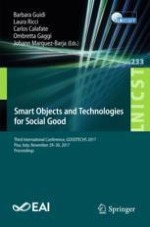2018 | Book
Smart Objects and Technologies for Social Good
Third International Conference, GOODTECHS 2017, Pisa, Italy, November 29-30, 2017, Proceedings
Editors: Barbara Guidi, Laura Ricci, Carlos Calafate, Ombretta Gaggi, Johann Marquez-Barja
Publisher: Springer International Publishing
Book Series : Lecture Notes of the Institute for Computer Sciences, Social Informatics and Telecommunications Engineering
